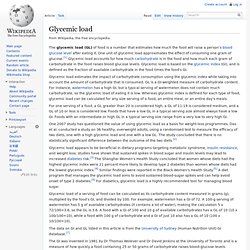

Glycemic load. The glycemic load (GL) of food is a number that estimates how much the food will raise a person's blood glucose level after eating it.

One unit of glycemic load approximates the effect of consuming one gram of glucose.[1] Glycemic load accounts for how much carbohydrate is in the food and how much each gram of carbohydrate in the food raises blood glucose levels. Glycemic load is based on the glycemic index (GI), and is defined as the fraction of available carbohydrate in the food times the food's GI. Glycemic index. The GI represents the total rise in a person's blood sugar level following consumption of the food; it may or may not represent the rapidity of the rise in blood sugar.

The steepness of the rise can be influenced by a number of other factors, such as the quantity of fat eaten with the food. The GI is useful for understanding how the body breaks down carbohydrates [2] and only takes into account the available carbohydrate (total carbohydrate minus fiber) in a food. Although the food may contain fats and other components that contribute to the total rise in blood sugar, these effects are not reflected in the GI. The glycemic index is usually applied in the context of the quantity of the food and the amount of carbohydrate in the food that is actually consumed. A related measure, the glycemic load (GL), factors this in by multiplying the glycemic index of the food in question by the carbohydrate content of the actual serving. Glycemic Index. Lose Weight with a Low-Glycemic Diet. Heart Rate Based Calorie Burn Calculator. This heart rate based calorie burn calculator (also known as a "heart rate based caloric expenditure calculator") provides an estimate of the rate at which you are burning calories during aerobic (i.e. cardiorespiratory) exercise, based on your average heart rate while performing the exercise.

During exercise your muscles must burn calories to fuel their contractions. The conversion of calories from their stored nutrient state to the form that can be burned by your muscle cells is achieved, during aerobic exercise, through the process of cellular respiration, which requires oxygen, and the delivery of oxygen through your bloodstream to your active muscle cells is directly related to your heart rate.